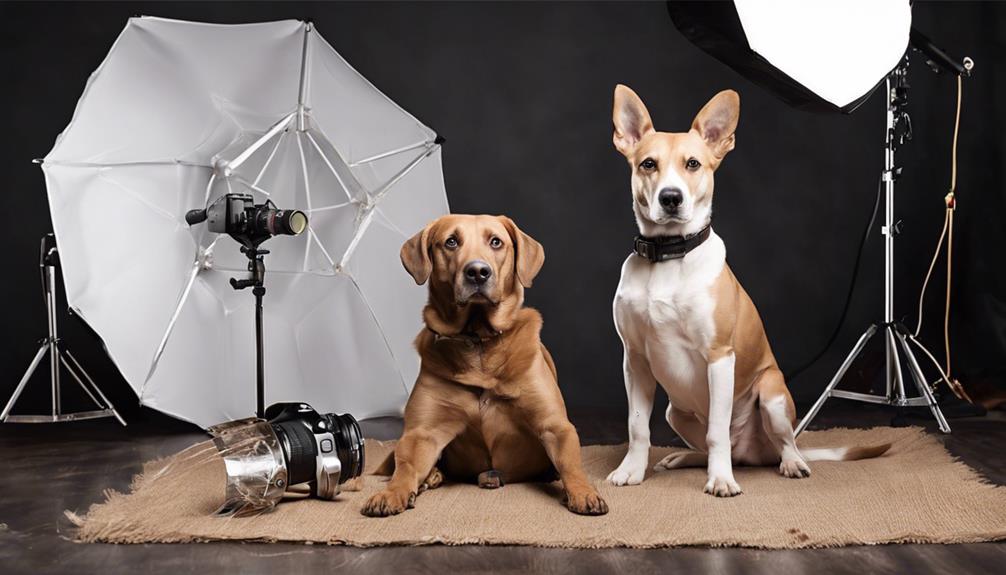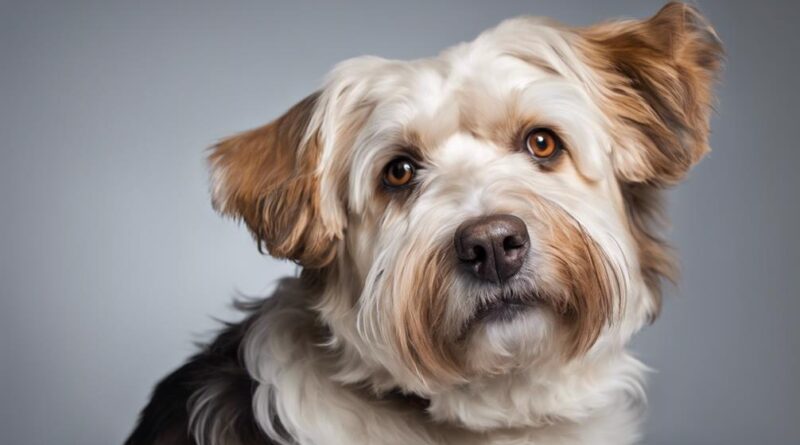Mastering Professional Dog Photography in Your Studio
As you set up your studio for professional dog photography, you may find yourself facing a unique set of challenges. From capturing the perfect expressions to managing energetic pups, every session brings its own surprises. But fear not, with the right techniques and a keen eye for detail, you can elevate your dog photography to new heights.
By mastering the art of working with canine subjects, you'll not only create stunning images but also forge a deeper connection with your furry clients and their owners.
Setting Up Your Dog Studio
When setting up your dog studio, ensure adequate lighting and comfortable seating for the pet owners. Studio decor plays a crucial role in creating a welcoming and professional atmosphere for both your clients and their furry friends. Consider using calming colors and pet-friendly furniture to make the space inviting. Incorporating elements like paw-printed cushions or dog-themed wall art can add a playful touch to the studio.
When it comes to backdrop options, choose versatile backdrops that complement the dog's fur color and personality. Neutral tones like beige or gray work well for most breeds, allowing the focus to remain on the dog. Additionally, consider using textured backdrops to add depth and interest to your photos. Experiment with different backdrop materials such as wood, brick, or fabric to create unique and captivating images.
Essential Photography Equipment
To capture stunning dog portraits in your studio, equip yourself with essential photography gear that includes a high-quality camera, versatile lenses, and reliable lighting equipment. When photographing dogs, it's crucial to pay attention to camera settings and composition to ensure you capture the perfect shot. Experiment with different aperture settings to achieve the desired depth of field and focus on the dog's eyes to create engaging portraits.
Essential Photography Equipment:
- Camera Settings and Composition:
- Adjust aperture for desired depth of field.
- Focus on the dog's eyes for engaging portraits.
- Backdrop Options and Props:
- Choose backdrops that complement the dog's fur color.
- Incorporate props to add personality to the photoshoot.
Having the right equipment and mastering camera settings and composition techniques will elevate your dog photography skills. Stay tuned for the next subtopic, 'Lighting Techniques for Dogs,' to further enhance your studio photography sessions.
Lighting Techniques for Dogs
Proper lighting techniques play a crucial role in capturing captivating dog portraits in your studio setting. When working with dogs, it's essential to consider creative angles that can highlight their unique features and personality. Experiment with different lighting setups to create depth and dimension in your photos.
Soft, diffused lighting can help to bring out the natural expressions of the dogs, capturing their emotions and character in a genuine way.
To achieve stunning dog portraits, try using lighting to emphasize the textures of their fur and the sparkle in their eyes. Avoid harsh shadows by positioning your lights strategically and using modifiers like umbrellas or softboxes. Remember that each dog is different, so be patient and observant to find the lighting setup that works best for each individual pup.
Posing and Working With Dogs
Consider adjusting your photography approach to suit the unique characteristics and behavior of each dog when posing and working with them in your studio. To capture their personality and expressions effectively, focus on the following tips:
- Get to Know the Dog: Spend some time getting acquainted with the dog before the photoshoot. Understand their likes, dislikes, and energy levels to tailor your approach accordingly.
- Use Treats and Toys: Engage the dog with treats or toys to encourage specific expressions or actions that you want to capture in your shots.
- Be Patient and Flexible: Dogs can be unpredictable, so remain patient and be ready to adapt to their movements and behaviors during the session.
- Experiment with Angles and Perspectives: Explore different angles and perspectives to create dynamic and engaging dog action shots that showcase their energy and spirit.
Creating a Dog-Friendly Environment
Ensure your studio space is welcoming and safe for dogs by implementing dog-friendly elements and minimizing potential hazards. Consider using soft, non-slip mats to provide a comfortable surface for dogs to stand or sit on during the photoshoot. This can help in calming anxious dogs and encouraging them to stay put. Additionally, have some toys or treats on hand to help keep the dogs engaged and focused during the session.
Understanding dog behavior is crucial in creating a dog-friendly environment. Pay attention to the body language of the dogs in your studio. Learn to recognize signs of stress or discomfort, such as panting, drooling, or avoiding eye contact. Implement calming techniques like soft, soothing voices and gentle petting to reassure nervous dogs and create a relaxed atmosphere.
Editing Tips for Dog Photos
To enhance the quality of your dog photos, start by mastering essential editing techniques for a polished final product. When editing dog photos, remember that color correction and retouching techniques play a crucial role in creating stunning images.
Here are some editing tips to help you improve your dog photography:
- Color Correction:
- Adjust the white balance to ensure accurate colors.
- Use selective color adjustments to make certain features pop.
- Retouching Techniques:
- Remove distractions like leashes or unwanted objects from the background.
- Soften fur imperfections or stray hairs for a flawless finish.
Marketing Your Dog Photography Business

Boost your dog photography business's visibility and attract more clients by implementing strategic marketing tactics tailored to your target audience. Building a strong social media presence is crucial in today's digital age. Utilize platforms like Instagram and Facebook to showcase your work, engage with potential clients, and network with other professionals in the pet industry. By consistently posting high-quality images and engaging content, you can attract a loyal following and increase your brand awareness.
When it comes to branding, ensure that your business's image is cohesive and reflects your unique style. Develop a logo, choose a color scheme, and create a consistent aesthetic across all your marketing materials. This will help potential clients recognize and remember your brand. Additionally, consider implementing pricing strategies that appeal to your target market. Whether you offer packages, a la carte options, or special promotions, make sure your pricing is competitive yet reflects the value of your services.
Client Communication and Satisfaction
How can you effectively communicate with your clients to ensure their satisfaction with your dog photography services? Building trust and relationships with your clients is essential for a successful photography business. Here are some key strategies to help you navigate client communication and achieve high satisfaction levels:
- Understand Client Expectations: Take the time to discuss and clarify what your clients expect from the photo session. Understanding their vision will help you deliver results that meet or exceed their expectations.
- Seek Feedback: Encourage open communication by seeking feedback from your clients throughout the process. This won't only show that you value their opinion but also allow you to make any necessary adjustments to ensure their satisfaction.
- Provide Regular Updates: Keep your clients informed about the progress of their photoshoot and any relevant details. This will help manage their expectations and prevent any misunderstandings.
- Show Appreciation: Express gratitude for their business and trust in your services. A little appreciation can go a long way in building lasting relationships with your clients.
Frequently Asked Questions
How Can I Ensure My Dog Subjects Are Comfortable and Relaxed During the Photoshoot?
To ensure your dog subjects are comfortable and relaxed during the photoshoot, focus on their well-being. Use canine comfort techniques and gentle posing methods. Building rapport with the dogs is key; offer treats, toys, and praise.
Create a calm environment by using soothing music or scents. Relaxation methods like massage can help ease any tension. By prioritizing their comfort and using these techniques, you can capture natural and beautiful moments during the photoshoot.
What Are Some Creative Ways to Incorporate Props or Costumes in Dog Photography?
To add flair to your dog photography, consider props and costumes. Props like hats, bow ties, or toys can showcase your dog's personality. Styling with themed accessories can elevate the overall look. Costumes matching a theme create fun and striking visuals.
Incorporate seasonal elements for variety. Subtle touches can enhance the essence of each dog's character. Be creative and experiment with different props and costumes to bring out the best in your furry subjects.
How Can I Capture the Unique Personalities of Each Dog in My Photos?
To capture the unique personalities of each dog in your photos, focus on using lighting techniques that highlight their features and expressions.
Choose backgrounds that complement their character and style.
Experiment with different editing styles to enhance their individuality.
Are There Any Specific Techniques for Photographing Dogs With Dark Fur or Lighter Fur?
When capturing dogs with dark or light fur, use different lighting techniques for contrast. To highlight dark fur, employ soft lighting and avoid harsh shadows. For lighter fur, create depth with subtle side lighting.
In editing, adjust exposure to bring out details in dark fur and prevent overexposure in light fur. Play with color contrast in backgrounds to make fur stand out. Use composition tricks like framing to draw attention to the dog's unique features.
Can You Provide Tips for Working With Multiple Dogs in a Group Shot?
When shooting a group of dogs, consider using a versatile lighting setup that evenly illuminates all the pups. Experiment with different compositions to capture each dog's unique personality.
Manage distractions by having a handler nearby to keep the dogs focused. Understand group dynamics to anticipate interactions and reactions.
Conclusion
Now that you have mastered professional dog photography in your studio, remember to continue honing your skills, staying up-to-date on equipment and techniques, and always putting the needs and comfort of the dogs first.
By creating a dog-friendly environment, using proper lighting techniques, and perfecting your editing skills, you can ensure that both you and your clients are satisfied with the final results.
Keep practicing and never stop learning in this rewarding field of photography.
